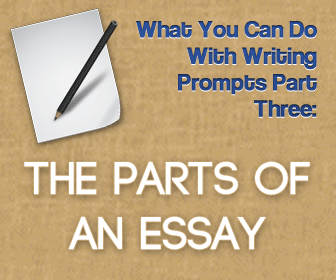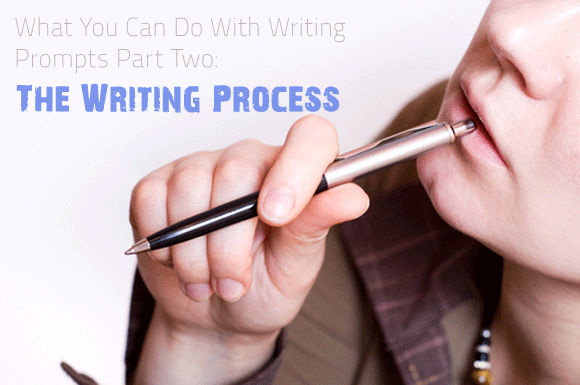What You Can Do With Writing Prompts Part Three: The Parts of an Essay


This is the second part of the series. View Part One here: What You Can Do With Writing Prompts Part One: Idea Generating.

No matter what writing class you are teaching, it is important to emphasize that writing is a process. Very few people can sit down and write a finished draft from start to finish, and those that do are probably not getting the quality writing that they could if they walked through the process. Your students will find POWER in the writing process when they realize they do not just sit down and write a composed piece in its final form from start to finish. This 5-step process includes Prewriting, Organizing, Writing, Editing and Rewriting (POWER). Writing prompts are a practical tool for not only the writing stage of the process but also the prewriting and organizing steps, so break the process down into little pieces for your students. They will be more effective writers if they can move toward their final goal of a well-written piece one small step at a time.
One of the simplest methods of prewriting, or generating ideas, is brainstorming. When a person or group of people brainstorms, they seek to compile a large list of possible answers to their question – as large a list as possible. As people share their ideas, the energy in the room builds and everyone’s creativity is awakened. You can brainstorm with your students in smaller groups, which may offer quieter students a less stressful atmosphere for sharing, or as a class, which will create the most energy and creativity. Either will be effective. When you use a writing prompt for a brainstorming session, be sure to choose one that has many possible answers so there is ample opportunity for all of your students to share.
Double Entry is similar to brainstorming, but it has a little more focus. Rather than making one list, double entry makes two lists as the same time, each focused on one aspect of the prompt. The most common type of double entry is probably the pros and cons list. You might also use double entry to list similarities and differences when doing a compare contrast essay. Use this method of prewriting to help your students think about how they would answer a writing prompt and what evidence they would give to support their thesis. Follow up by writing the essay if you like or just practice prewriting. Either way your students will gain useful experience through the process.
When your students are writing an essay, they will need to use different types of organization depending upon the type of essay they are writing and the content in their final piece. In some cases, they will need to use spacial organization, which organizes the examples moving from one direction to another. This could be left to right, top to bottom, east to west or any other way that seems to make sense. Using the writing prompt, have your students list three examples that they might use to answer the question. Then, have them make sure the examples are organized according to space.
There may be times that organizing supporting details is better done by degree of familiarity, that is, how unusual each of the examples are. When this is the case, writers should organize from familiar to unfamiliar. This eases the reader into the essay and helps him or her transition in thought from one example to the next. Using a prompt, have your students list possible examples which support the main point of the essay and then rank those examples from most familiar to least familiar. This type of organization will give the reader a point of connection with the writer and move them gently to the examples that may seem to be more out of the ordinary.
Another type of organization that writers often use in a typical five-paragraph essay is organization from least impactful to most impactful. With the idea of a grand finale and saving the best for last, this type of organization leaves the reader with the strongest argument that the writer presents at the end of the essay. Using a writing prompt, have your students list some arguments that they might use to present their point of view. Once they have those examples or reasons, have them number them in order of impactfulness saving the most impactful for the grand finale.
Another type of organization uses time as its underlying structure. This type of organization is commonly referred to as chronological organization. Your students should plan to use this type of organization for any narrative piece of writing, such as a story from their lives, or any historical piece. Using the logical and straightforward process that follows a time line helps the reader. To practice this type of organization, you can have your students simply list the events he or she would write about in a numbered list, on a schedule or on a calendar.
Perhaps the most obvious use of writing prompts is for writing assignments. There are several types of writing assignments that an ESL teacher can give his or her students, and having students write a composition for homework may be the most common of those. As part of teaching the writing process, you will want to have your students write composed pieces, nonfiction and fiction, which test their English writing skills. Writing a complete piece takes time and effort as well as walking through the entire writing process. The pieces that your students write to fulfill the assignments you give may be based on personal experience, require some research or simply ask your students for their opinions on a certain topic. The complexity of the topic will depend on how long your students have for the assignment (a week is generally a good length of time for a standard five-paragraph essay or a 500-word composition). You may also choose to tie the topic into something you are studying in if you follow a theme in your language studies. Really, you can assign almost any writing topic for an at home assignment; here are just a couple of suggestions.
An in class writing is one of the most useful tools for the ESL teacher. The advantage comes because a student does not have the resources he or she has available outside of class. When a student writes a piece at home, he can have more advanced language learners or native speakers look at and correct the piece or use more objective tools like spell check and grammar check. In the worst cases, students may do more than borrow material from other sources which will create the need to address plagiarism. An in class writing will give you a truer picture of where your students’ writing skills lie without the cloudiness that comes from editing resources they might use outside of the classroom. For this type of writing, though, keep the topic less complex since your students will be coming up with their ideas on the spot.
One step further than an in class writing is a timed writing. Because many ESL students will end up in higher education situations in which they must use English, they will often take essay-based tests or standardized tests which will have time limits. Giving your students practice with timed writings will help prepare them for their academic futures and hopefully decrease their stress when they have to write quickly in the future. For a thirty to forty-five minute timed writing, keep the topic very straightforward and somewhat simple. Because the time is so limited, choosing a topic on the simple side will allow your students to devote most of their time to writing rather than generating ideas and planning their organization.
Revision is an important part of the writing process though it is easily overlooked by the writing teacher. Using a piece that your students have written from a prompt, teach your class the bottom up proofreading strategy. In this process, students begin with the last sentence in their written piece and check it for grammatical issues. After correcting any in that sentence, the student moves to the previous sentence and looks at it in isolation as well, correcting any mistakes he finds. In this manner, he should move through the entire piece, one sentence at a time, making corrections. The advantage to this method is that he does not get distracted by ideas and flow and can focus on grammatical issues. Using any composition your students have written, take one more look at the piece in this fashion and see if your students can locate any last minute errors they may wish to correct.
The final step in the writing process is rewriting. In this step, your students should read their final piece for style, organization and grammatical errors. You can help them be successful if you communicate the specific points on which you are grading their writing. If your students know the criteria you are using to score their essays and are able to look for those skills in their own writing, they will know which areas they need to improve. To do this, show your students how a rubric is used to grade essays. Then give them a writing prompt and have them either do an in class writing or write a piece for homework. Students can then score their own work by using the rubric before you ever take a look at it. As it is always useful to have a second set of eyes, give students partners to read and score their essays using the same rubric. Your students will then know how they can improve this and future pieces that they write. Then have your students rewrite the piece making the suggested changes and then turn in the revised copy with the original. Just about any topic will work with this exercise, though something requiring straightforward examples may be easiest for your students to score.
Though most writing prompts elicit some type of composition, you can use them even if you are taking the writing process one piece at a time. You can always walk through all the steps of the process with any one prompt, or change up the prompts to keep your students’ interest high. Either way, your students will show more organization, support and fluency in their writing.
Don’t Miss: BusyTeacher’s eBook 300 Creative Writing Ideas PLUS 100 Exclusive Graphic Prompts!
Turbocharge your lessons with these 300 fresh and creative writing ideas! One-of-a-kind prompts are great as conversation starters, too!